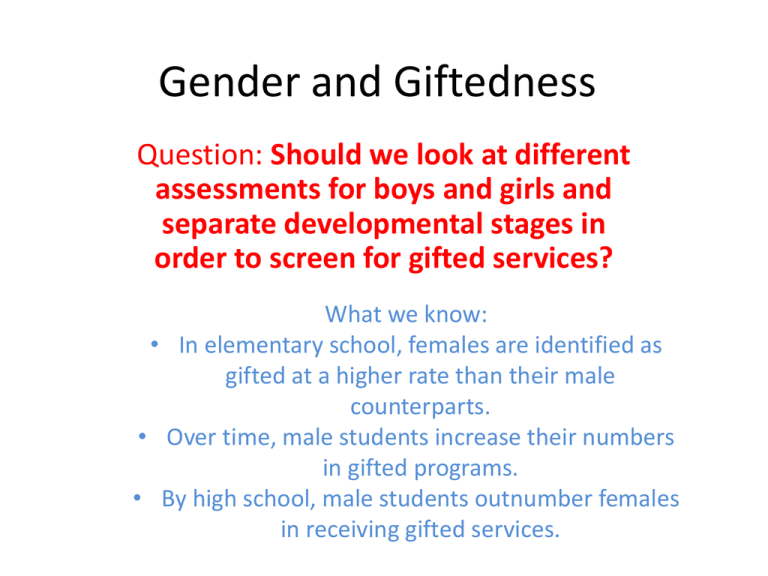Gender and Giftedness
advertisement

Gender and Giftedness Question: Should we look at different assessments for boys and girls and separate developmental stages in order to screen for gifted services? What we know: • In elementary school, females are identified as gifted at a higher rate than their male counterparts. • Over time, male students increase their numbers in gifted programs. • By high school, male students outnumber females in receiving gifted services. Early identification disparities • Boys develop slower than girls to the point that boys develop language skills and large and small muscle proficiencies at a developmentally different tempo from girls. Gender differences • Girls talk earlier than boys, have larger pre-school vocabularies, and use more complex sentence structures. Once in school, girls are one to oneand-a-half years ahead of boys in reading and writing. Boys are twice as likely to have a language or reading problem and three to four times more likely to stutter. Girls do better on tests of verbal memory, spelling and verbal fluency. On average, girls utter two to three times more words per day than boys and even speak faster---twice as many words per minute. • A growing body of research on these differences points us to a girl brain built with a language head start. During infancy the left hemisphere (the brain's language center for most people) develops before the right for little girls whereas the order is reversed for boys. Even more convincing, females have at least twenty % more neurons than males in the brain's Broca area (where we produce language), and they have as much as 18% more volume in the Wernicke's area (where we interpret language). Dr. David Walsh, Ph.D. http://www.pbs.org/parents/experts/archive/2012/09/boy-and-girl-brainswhats-the.html The corpus callosum portion of the brain in boys is smaller than in girls • The corpus callosum is a group of nerve fibers that connect the two hemispheres of the brain. • This means that the two hemispheres are extensively connected in girls to allow a faster and more robust exchange of certain types of information such as relational information and information relating to attributes of objects and language. • The result of this is: • Girls do better than boys in reading comprehension. • Perceptual speed • And word association memory.(Bruskiewich, 2001) Testing gender bias • Hale & Potok studied the sexual bias in the WISC-R with respect to the overrepresentation of boys in special education classes. They found that girls scored five points higher than boys http://www.ukessays.com/essays/education/intelligence-test-use-biaseducation-essay.php#ixzz35B12D6FV Looking at IQ tests that tested language abilities, the Northwestern researchers confirmed that girls outperformed boys overall. • They found that boys relied more on vision and hearing to make language judgments, while girls were using more abstract, than sensory, parts of the brain. • So what difference does it make in the classroom or life? • "For girls, it doesn't matter whether you are reading or hearing the words, the information gets converted into an abstract meaning, an abstract thought. For boys, the research suggests it's really going to be very important whether they're hearing or reading words. That is going to determine how well they're processing the language." • He said that based on these results, girls may have an advantage in testing, at least in elementary and middle school. Boys may have more difficulty with written tests but fare better with oral tests on lectures and written tests for reading.(Wolinsky, 2008) Testing Bias • Females tend to perform better than men on tests of perceptual speed, in which subjects must rapidly identify matching items for example, pairing the house on the far left with its twin: • In addition, females remember whether an object, or a series of objects, has been displaced: • On some tests of ideational fluency, for example, those in which subjects must list objects that are the same color, and on tests of verbal fluency, in which participants must list words that begin with the same letter, females also outperform males: • Females do better on precision manual tasks-that is, those involving fine-motor coordination-such as placing the pegs in holes on a board: Testing Bias Continued • And females do better than males on mathematical calculation tests: • Males tend to perform better than females on certain spatial tasks. They do well on tests that involve mentally rotating an object or manipulating it in some fashion, such as imagining turning this threedimensional object • or determining where the holes punched in a folded piece of paper will fall when the paper is unfolded: • Males also are more accurate than females in target-directed motor skills, such as guiding or intercepting projectiles: Testing Bias • Terman found slight bias in favor of girls regarding the Stanford-Binet intelligence test. (Terman, 1916, pp. 6070).Psychology Today • An Educational Testing Service (ETS) study found that males score an average of 35 points higher on the math part of the Scholastic Assessment Test (SAT) than females, even when the two sexes get the same grades in their college math courses. [16] Some observers theorize that males solve problems with analytical, deductive kinds of reasoning while females tend to approach them with a more innovative, open-minded flair that multiple-choice tests can't capture.(Glaser, 1993) Gender Disparities in Adolescence • Gender differences favoring boys appear at adolescence and increase during the high school years, but only in areas involving mathematics problem solving. Since the late 1970’s boys have consistently scored 10% higher than girls on the math portion of the SAT J.L. Cook – G. Cook 4/30/14 Implications • Developmental differences in gender, bias early identification of giftedness against males. • Intelligence tests utilized on a large scale, ie. WISC and Stanford Binet, have shown bias against males. • During adolescence there is a shift in assessments where males are increasing test scores. Conclusions • Male students should be tested according to their developmental stage, with retesting consideration given to elementary age boys. • Careful consideration needs to be given to males when administering Intelligence Tests with focus on developmental strengths.








